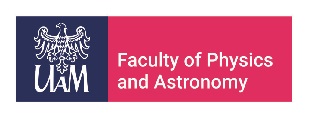
Prof. dr hab. Zbigniew Tylczyński, senior
Department of Physics of Nanostructures
- Tel: +48 61 829 5199
- Loc: wing G, first floor, room 182
- Email: zbigtyl@amu.edu.pl
Scientific degrees
Title of professor – 2007
Habilitation – 1993
Publications
2022 |
|
| 3. | M Szafrański, Zbigniew Tylczyński, M Wiesner, P Czarnecki, V V Ghazaryan, A M Petrosyan Materials & Design, 220 , pp. 110893, 2022, ISSN: 0264-1275. @article{SZAFRANSKI2022110893, title = {Above-room-temperature ferroelectricity and piezoelectric activity of dimethylglycinium-dimethylglycine chloride}, author = {M Szafrański and Zbigniew Tylczyński and M Wiesner and P Czarnecki and V V Ghazaryan and A M Petrosyan}, url = {https://www.sciencedirect.com/science/article/pii/S0264127522005159}, doi = {https://doi.org/10.1016/j.matdes.2022.110893}, issn = {0264-1275}, year = {2022}, date = {2022-06-27}, journal = {Materials & Design}, volume = {220}, pages = {110893}, abstract = {Heavy-metal-free ferroelectrics are sought as environmentally compatible alternatives to commonly used inorganic oxides. Here, we demonstrate direct evidence of the ferroelectric properties of a hybrid organic–inorganic material, dimethylglycinium-dimethylglycine chloride. At room temperature, the compound crystallizes in the polar space group P21 and exhibits a switchable spontaneous polarization of 1.9 μC cm−2. Ferroelectric properties are preserved in a wide temperature range up to about 401 K, where the crystal undergoes the transition to the paraelectric phase of the space group P21/c. The temperature-dependent single-crystal X-ray diffraction study and the calorimetric data indicate an order–disorder contribution to the transition mechanism, which is consistent with the critical slowing down of the dielectric relaxation observed near the Curie point. The spontaneous polarization results from ionic displacements that are induced by changes in the disordering of the dimeric cations. In the ferroelectric phase, the crystal exhibits remarkable piezoelectric activity. The electromechanical and elastic properties of the material were thoroughly characterized.}, keywords = {}, pubstate = {published}, tppubtype = {article} } Heavy-metal-free ferroelectrics are sought as environmentally compatible alternatives to commonly used inorganic oxides. Here, we demonstrate direct evidence of the ferroelectric properties of a hybrid organic–inorganic material, dimethylglycinium-dimethylglycine chloride. At room temperature, the compound crystallizes in the polar space group P21 and exhibits a switchable spontaneous polarization of 1.9 μC cm−2. Ferroelectric properties are preserved in a wide temperature range up to about 401 K, where the crystal undergoes the transition to the paraelectric phase of the space group P21/c. The temperature-dependent single-crystal X-ray diffraction study and the calorimetric data indicate an order–disorder contribution to the transition mechanism, which is consistent with the critical slowing down of the dielectric relaxation observed near the Curie point. The spontaneous polarization results from ionic displacements that are induced by changes in the disordering of the dimeric cations. In the ferroelectric phase, the crystal exhibits remarkable piezoelectric activity. The electromechanical and elastic properties of the material were thoroughly characterized. |
2021 |
|
| 2. | Zbigniew Tylczyński Frontiers of Physics, 14 (6), pp. 63301, 2021, ISSN: 2095-0462. @article{tylczynski_collection_2019, title = {A collection of 505 papers on false or unconfirmed ferroelectric properties in single crystals, ceramics and polymers}, author = {Zbigniew Tylczyński}, url = {https://journal.hep.com.cn/fop/EN/10.1007/s11467-019-0912-5}, doi = {10.1007/s11467-019-0912-5}, issn = {2095-0462}, year = {2021}, date = {2021-11-19}, journal = {Frontiers of Physics}, volume = {14}, number = {6}, pages = {63301}, abstract = {textlessptextgreaterThis collection presents 505 papers on ferroelectricity in single crystals, ceramics and polymers in which pointed or elliptical hysteresis loops would testify to their ferroelectric properties. In some papers, the authors ensure that ferroelectricity can occur even in materials that do not have a polar axis of symmetry.textless/ptextgreater}, keywords = {}, pubstate = {published}, tppubtype = {article} } textlessptextgreaterThis collection presents 505 papers on ferroelectricity in single crystals, ceramics and polymers in which pointed or elliptical hysteresis loops would testify to their ferroelectric properties. In some papers, the authors ensure that ferroelectricity can occur even in materials that do not have a polar axis of symmetry.textless/ptextgreater |
| 1. | Pontus Laurell, Allen Scheie, Chiron J Mukherjee, Michael M Koza, Mechtild Enderle, Zbigniew Tylczyński, Satoshi Okamoto, Radu Coldea, Alan D Tennant, Gonzalo Alvarez Quantifying and Controlling Entanglement in the Quantum Magnet Cs2CoCl4 Phys. Rev. Lett., 127 , pp. 037201, 2021. @article{PhysRevLett.127.037201, title = {Quantifying and Controlling Entanglement in the Quantum Magnet Cs2CoCl4}, author = {Pontus Laurell and Allen Scheie and Chiron J Mukherjee and Michael M Koza and Mechtild Enderle and Zbigniew Tylczyński and Satoshi Okamoto and Radu Coldea and Alan D Tennant and Gonzalo Alvarez}, url = {https://link.aps.org/doi/10.1103/PhysRevLett.127.037201}, doi = {10.1103/PhysRevLett.127.037201}, year = {2021}, date = {2021-07-13}, journal = {Phys. Rev. Lett.}, volume = {127}, pages = {037201}, publisher = {American Physical Society}, abstract = {The lack of methods to experimentally detect and quantify entanglement in quantum matter impedes our ability to identify materials hosting highly entangled phases, such as quantum spin liquids. We thus investigate the feasibility of using inelastic neutron scattering (INS) to implement a model-independent measurement protocol for entanglement based on three entanglement witnesses: one-tangle, two-tangle, and quantum Fisher information (QFI). We perform high-resolution INS measurements on Cs2CoCl4, a close realization of the S=1/2 transverse-field XXZ spin chain, where we can control entanglement using the magnetic field, and compare with density-matrix renormalization group calculations for validation. The three witnesses allow us to infer entanglement properties and make deductions about the quantum state in the material. We find QFI to be a particularly robust experimental probe of entanglement, whereas the one and two-tangles require more careful analysis. Our results lay the foundation for a general entanglement detection protocol for quantum spin systems.}, keywords = {}, pubstate = {published}, tppubtype = {article} } The lack of methods to experimentally detect and quantify entanglement in quantum matter impedes our ability to identify materials hosting highly entangled phases, such as quantum spin liquids. We thus investigate the feasibility of using inelastic neutron scattering (INS) to implement a model-independent measurement protocol for entanglement based on three entanglement witnesses: one-tangle, two-tangle, and quantum Fisher information (QFI). We perform high-resolution INS measurements on Cs2CoCl4, a close realization of the S=1/2 transverse-field XXZ spin chain, where we can control entanglement using the magnetic field, and compare with density-matrix renormalization group calculations for validation. The three witnesses allow us to infer entanglement properties and make deductions about the quantum state in the material. We find QFI to be a particularly robust experimental probe of entanglement, whereas the one and two-tangles require more careful analysis. Our results lay the foundation for a general entanglement detection protocol for quantum spin systems. |


